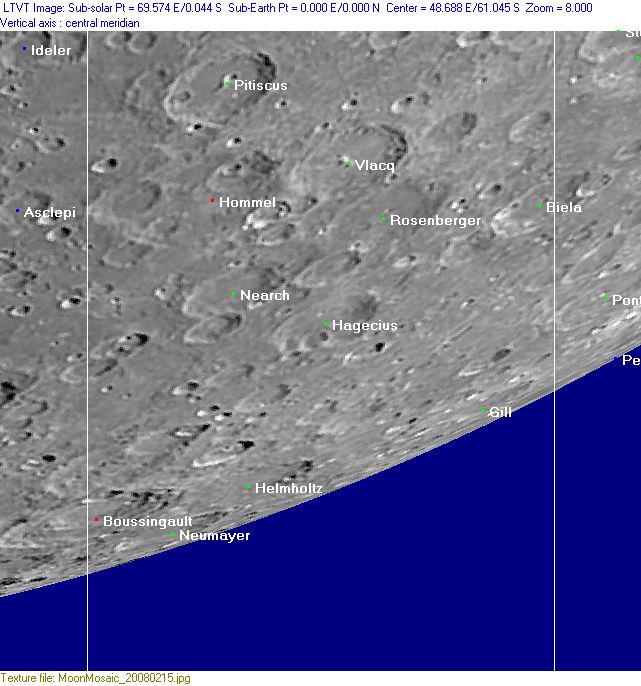Difference between revisions of "Rükl 75"
| Line 56: | Line 56: | ||
(click on the thumbnails to view full-sized images; use browser BACK button to return to this page)<br /> <br /> | (click on the thumbnails to view full-sized images; use browser BACK button to return to this page)<br /> <br /> | ||
===Full zone with [[Satellite%20feature|lettered craters]]=== | ===Full zone with [[Satellite%20feature|lettered craters]]=== | ||
| − | [http://the-moon.us/wiki/file/detail/Rukl_75_satellites.jpg [[Image:Rukl_75_satellites.jpg|external image Rukl_75_satellites.jpg | + | [http://the-moon.us/wiki/file/detail/Rukl_75_satellites.jpg [[Image:Rukl_75_satellites.jpg|external image Rukl_75_satellites.jpg|64x64px]]]<br /> <br /> |
===Lettered craters by quadrants=== | ===Lettered craters by quadrants=== | ||
(the dashed white lines are the centerlines of the Rükl zones)<br /> | (the dashed white lines are the centerlines of the Rükl zones)<br /> | ||
| Line 64: | Line 64: | ||
|- | |- | ||
| | | | ||
| − | [http://the-moon.us/wiki/file/detail/Rukl_75_satellites_NW.jpg [[Image:Rukl_75_satellites_NW.jpg|external image Rukl_75_satellites_NW.jpg | + | [http://the-moon.us/wiki/file/detail/Rukl_75_satellites_NW.jpg [[Image:Rukl_75_satellites_NW.jpg|external image Rukl_75_satellites_NW.jpg|64x64px]]]<br /> |
| | | | ||
| − | [http://the-moon.us/wiki/file/detail/Rukl_75_satellites_NE.jpg [[Image:Rukl_75_satellites_NE.jpg|external image Rukl_75_satellites_NE.jpg | + | [http://the-moon.us/wiki/file/detail/Rukl_75_satellites_NE.jpg [[Image:Rukl_75_satellites_NE.jpg|external image Rukl_75_satellites_NE.jpg|64x64px]]]<br /> |
|- | |- | ||
| | | | ||
| − | [http://the-moon.us/wiki/file/detail/Rukl_75_satellites_SW.jpg [[Image:Rukl_75_satellites_SW.jpg|external image Rukl_75_satellites_SW.jpg | + | [http://the-moon.us/wiki/file/detail/Rukl_75_satellites_SW.jpg [[Image:Rukl_75_satellites_SW.jpg|external image Rukl_75_satellites_SW.jpg|64x64px]]]<br /> |
| | | | ||
| − | [http://the-moon.us/wiki/file/detail/Rukl_75_satellites_SE.jpg [[Image:Rukl_75_satellites_SE.jpg|external image Rukl_75_satellites_SE.jpg | + | [http://the-moon.us/wiki/file/detail/Rukl_75_satellites_SE.jpg [[Image:Rukl_75_satellites_SE.jpg|external image Rukl_75_satellites_SE.jpg|64x64px]]]<br /> |
|- | |- | ||
| South West<br /> | | South West<br /> | ||
Latest revision as of 17:03, 22 April 2018
Contents
Rükl Zone 75 - HAGECIUS
Neighboring maps on the Rükl Nearside Map:
| 75 |
||
Photographic Map
(This map is based on an Earth-based photograph that has been computer-corrected to zero libration. The vertical white lines indicate the left and right boundaries of the Rükl rectangle)
Background image source
Nearside Named Features
- Asiae pars (J.Hewelcke's disallowed name for the south-southeastern limb region) (although E.A.Whitaker isn't really sure about that).
- Biela
- Boussingault
- Gill
- Hagecius
- Helmholtz
- Hommel (Van Langren's Konie c Polski) (J.Hewelcke's Mons Dalanguer) (in E.A.Whitaker's book mentioned as Mons Delanguer).
- Janssen (J.F.J.Schmidt's disallowed name for Boussingault E).
- Mons Caes (a strictly unofficial name for a previously unnamed elevation north of Helmholtz F, see Additional Information below).
- Mons Dalanguer (J.Hewelcke's disallowed name for the IAU's Hommel, Nearch, and Vlacq).
- Mutus-Vlacq Basin (an unofficial name) (see also Rukl Zone 74).
- Nearch (J.Hewelcke's Mons Dalanguer) (in E.A.Whitaker's book mentioned as Mons Delanguer).
- Neumayer
- Peters (J.F.J.Schmidt's disallowed name for Rosenberger D).
- Pitiscus (Van Langren's Guasco).
- Rosenberger
- SELENE (Kaguya) main orbiter (impacted on June 10, 2009, southeast of Gill).
- Terra Fertilitatis (Riccioli's discontinued name for the whole of Chart 75).
- van Monckhoven (an unofficial name from D.Caes for Rosenberger B, south of the couple Steinheil and Watt, see Additional Information below).
- Vlacq (Van Langren's Philip Christ. Elect. Treu.) (J.Hewelcke's Mons Dalanguer) (in E.A.Whitaker's book mentioned as Mons Delanguer).
Farside Named Features
(The following features are not formally included in the present Rükl rectangle, but they are adjacent to it and their centers are less than 10° beyond the mean limb -- so they may be seen here in whole or in part with a favorable libration)
- Sikorsky
- Vallis Schrödinger
- Vallis Wexler (an unofficial name from D.Caes for the broad shallow valley west-northwest of Wexler).
- Wexler
Lettered Crater Locations
(click on the thumbnails to view full-sized images; use browser BACK button to return to this page)
Full zone with lettered craters
Lettered craters by quadrants
(the dashed white lines are the centerlines of the Rükl zones)
| North West |
North East |
| South West |
South East |
Additional Information
- Other online descriptions of features in this Rükl map section:
Mons Caes
- At 63°30' South/ 60° East, northwest of Helmholtz (north of Helmholtz F), there's a solitary mountain-like elevation which doesn't seem to have received an official or unofficial name. Moon-observer Danny Caes (who discovered or re-discovered that elevation during the night of may the 23th 1997) calls it Mons Caes. The best time to observe that solitary mountain-like elevation is when the evening terminator runs at 65° East (local sunset), a couple of days after Full Moon (between Full Moon and Waning Gibbous Moon).
- The above mentioned mountain-like elevation (north of Helmholtz F) is depicted on several plates in the Hatfield Photographic Lunar Atlas. The best plate (on which the mount is visible) is Plate 16b. The exact location of the mount (on the printed version of the photograph) is: 78 millimeter below the image's upper margin, and 75 millimeter rightward of the image's left margin. In the same atlas, at Plate 14c, the mount's location is: 51 millimeter below the image's upper margin, and 8 millimeter rightward of the image's left margin. On Plate 16d, it (the mount) is visible at 65 millimeter below the image's upper margin, and 86 millimeter rightward of the image's left margin.
- Mons Caes is also visible on page 23 (Chart 5, location B-7/8) and page 74 (Libration Chart L3, lower left corner) in the 21st Century Atlas of the Moon (C.A.Wood/ M.Collins).
van Monckhoven (Rosenberger B, south of Steinheil and Watt)
- Desire Van Monckhoven (1834-1882, Belgian chemist, physicist, and photographic researcher). Moonobserver Danny Caes is anxiously trying to get van Monckhoven's name south of both the couple Steinheil and Watt, because of the Cooke-Steinheil/Watt refractor telescope which van Monckhoven was responsible for (located at the observatory of the university of Ghent-Belgium). Many observations of the moon were performed by D.Caes at van Monckhoven's observatory (from 1995 to 2007), and lots of these observations are mentioned throughout the pages of the MOON-WIKI Project.





